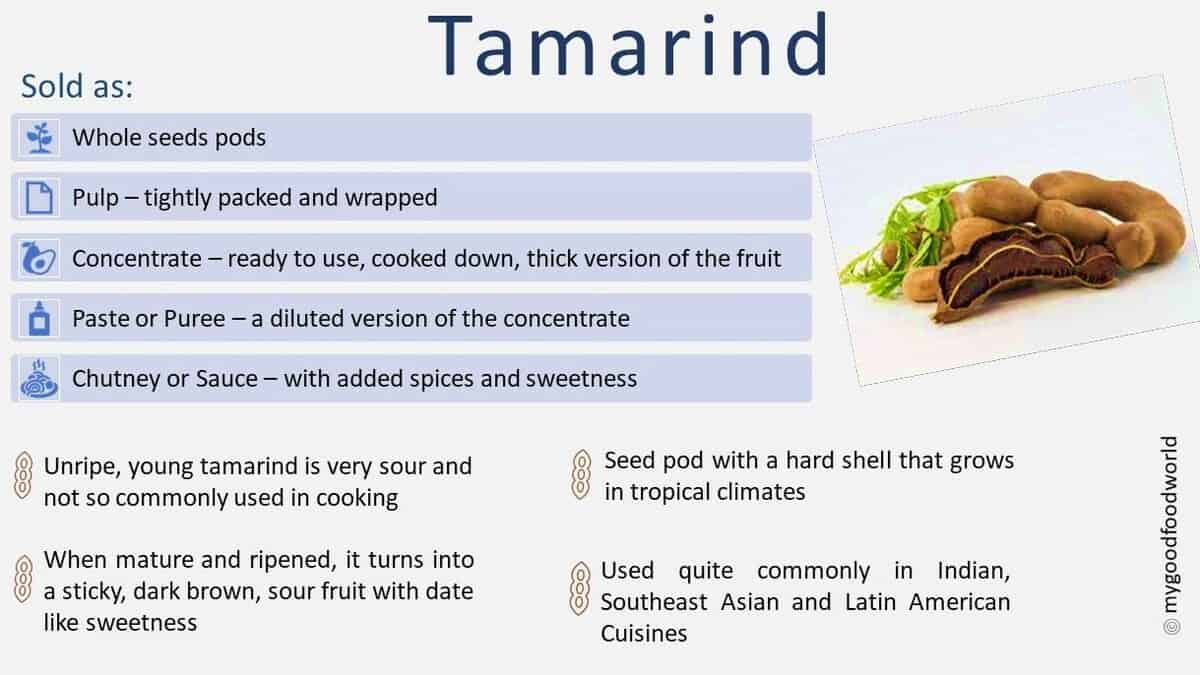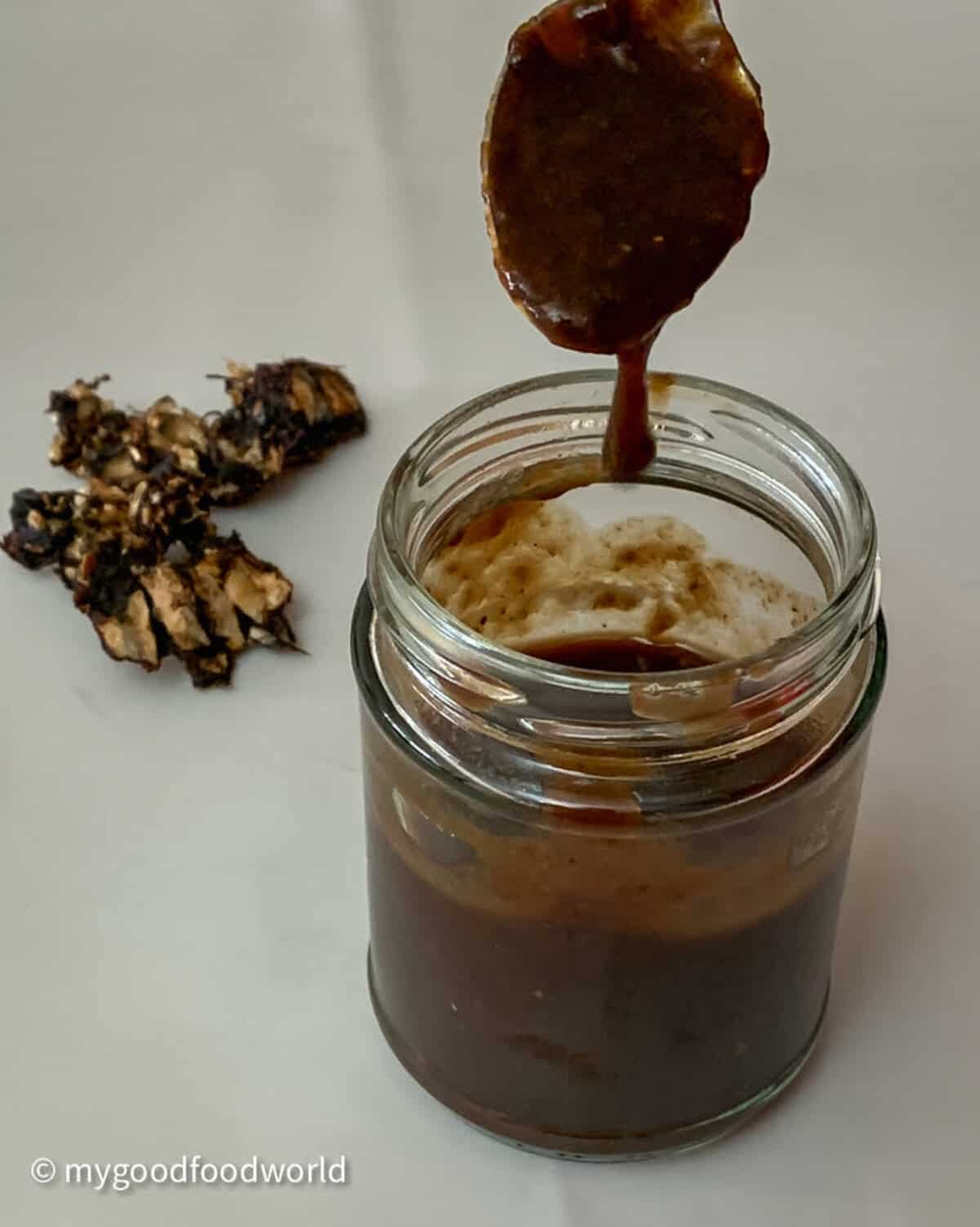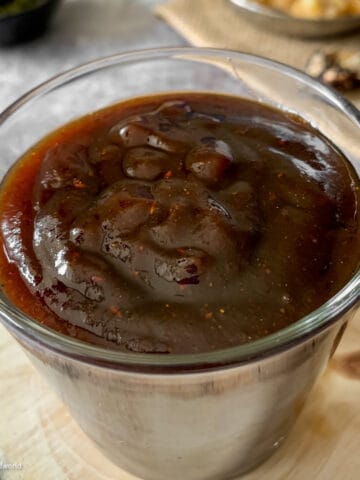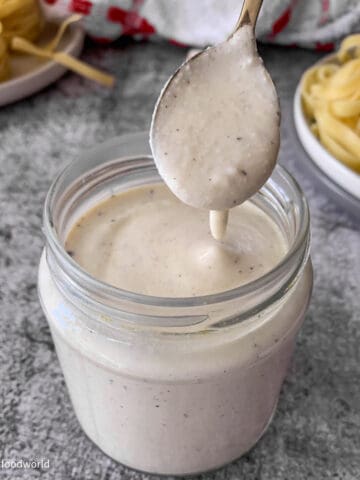My tamarind paste recipe comes together in just 15 minutes and is free from additives. Just a spoonful of this homemade goodness is guaranteed to add oodles of flavor to your dish! The best part? it lasts for weeks and therefore great for meal prep!

Save This Recipe
Enter your email & I'll send it to your inbox.
By submitting this form, you consent to receive emails from MyGoodFoodWorld
This tamarind paste recipe is my mum’s, and I’ve been seeing bottles of homemade tamarind pulp in our fridge for as long as I can remember. And you know me—I love fresh food, but I’m also all about spending less time in the kitchen.
That’s why ingredient prepping is a big part of my routine. A little effort upfront saves so much time later! My fridge is always stocked with the essentials—some ginger garlic paste (this garlic ginger paste recipe), chili oil for a spicy kick (this garlic chili oil recipe), a batch of cooked red lentils (learn how to cook red lentils), sprouted mung beans (learn how to grow thick mung bean sprouts at home), and my go-to sauces for when an Italian meal is calling—this cream cheese tomato pasta sauce and my hearty marinara sauce.
What do you do with tamarind paste? It’s so versatile! You can use it in everything from curries to salads, relishes, and even stews. I love how simple it is to make but how much it elevates my cooking. More on that later, but trust me, it’s going to become a regular in your kitchen too! This tamarind paste recipe makes a big batch that lasts me weeks.
This post includes helpful tips, but if you're in a hurry, use the "Jump to Recipe" or section links to skip ahead.
Jump to:
Recipe Overview
This easy tamarind paste recipe is free of all top 14 allergens. It’s a great condiment to keep in your fridge for an easy way to add loads of flavor to any dish.

Ease: Making homemade tamarind pulp takes just 15 minutes and requires only two ingredients. Plus, it’s completely free of additives.
Versatile: You can use tamarind paste in any recipe where you want a bit of tanginess. It’s delicious in curries, soups, salad dressings, and even drinks! Check out the section below for more ideas.
Stores well: Tamarind paste stays fresh in the fridge for up to 2 weeks. See the section below for more storage details.
Equipment: No fancy gadgets needed—just your hands, a couple of bowls, and a sieve! .
How thick should tamarind paste be?
Tamarind paste should be thick and smooth, almost like ketchup but a little more scoopable. It shouldn’t be too runny, but not so thick that it won’t mix easily into dishes. If it feels too dense, loosen it with a bit of water before using it!
What is Tamarind?
Tamarind (Imli in Hindi) is a sticky, sour fruit that grows in pods. When unripe, its hard shell is greenish-brown, and the flesh inside is intensely tart. As it ripens, the shell turns brown, and the flesh develops a sweet, date-like aroma while staying tangy.
Widely used in Indian, Southeast Asian, and Latin American cooking, tamarind adds a rich depth of flavor. It’s also packed with nutrients like iron, magnesium, and phosphorus!

Tamarind Concentrate vs.Tamarind Puree
It's easy to get mixed up between these terms, so let me break it down.
Tamarind concentrate is a thick, smooth, and intensely flavored version of tamarind that has been cooked down. It’s usually sold in jars or tubs in grocery stores and often contains preservatives.
Tamarind Puree or paste, known as imli paste in Hindi, is a slightly diluted, more pourable form of tamarind concentrate. The terms tamarind paste, purée, and concentrate are sometimes used interchangeably, which can add to the confusion.

Tamarind pulp vs paste
Tamarind pulp is the starting point of making tamarind paste. The tightly packed block of dried tamarind fruit, usually wrapped in clear plastic that you can buy from grocery stores, is known as pulp. It often contains seeds and fibrous strings. The pulp isn’t used directly in cooking. Instead, it’s cleaned and processed into paste, purée, or concentrate before use.
Tamarind Paste Ingredients

For the complete list of ingredients, their exact quantities, and the full instructions, scroll down to the recipe card below.
Tamarind: I have made this recipe with the fruit that is deseeded and cleaned. You can use fresh tamarind pods or tamarind pulp instead. Just make sure to remove the seeds and as much of the fiber as you can.
Water: For the fastest result, use hot (just boiled) water for this recipe.
If you have any questions regarding these ingredients, feel free to ask in the comments section below and I will try my best to answer them for you.
Instructions
Let's learn how to make tamarind paste.
Start by removing the pulp or fruit from its wrapping and remove any fibers and seeds.
Place the tamarind in a large bowl and pour the boiling water over it. Cover and set aside for 10 minutes.

When it is cool enough to handle, squeeze and massage the tamarind with your hand for 2-3 minutes (set a timer!). As you squeeze and massage the pulp, you will notice that the amber-colored water starts to thicken and become pulpy.


Transfer the pulp to a sieve placed over a bowl. Using a large spoon, press and strain out the extract—this first extract is thick and pasty and is your tamarind paste.

Place the remaining pulp back into the bowl, add ½ cup of water, and squeeze for another 2 minutes. Transfer it to a sieve with a fresh bowl underneath and strain again. This second extract is thinner than the first.
Repeat this process 5–6 more times, adding ¼ cup of water each time, until the water becomes nearly colorless. These later extracts will be increasingly thin—this is your tamarind water.

Discard the fibrous bits, and you’ll be left with thick, smooth tamarind paste and the thinner extract (tamarind water).
Recipe Notes
Yield: This recipe yields approximately 7⅛ oz. (200g) of thick tamarind paste. The second extract through the final one will yield about 17¾ oz. (400g), bringing the total yield to around 24¾ oz. (700g).
Adding in the water: For this recipe, you’ll need to add water in stages. First, you’ll use 1 cup, then ½ cup for the second extract, and from the third extract onward, ¼ cup per batch. In total, you’ll need about 3 cups of water.
Tamarind paste vs. tamarind water: You’ll notice me using these terms throughout the recipe, so here’s a quick clarification. Tamarind paste refers to the first extract, which is thick. Tamarind water is the thinner liquid you get from the second extract onward.
Don’t Have a Sieve? No worries! Just squeeze the extract through your palm. It’s fine if some pulpy bits end up in the liquid—just be sure to leave out the fibers.
Recipe tips
Use hot (just-boiled) water – Hot water helps soften the tamarind quickly, making it easier to extract a smooth paste. Let it soak for at least 10 minutes before squeezing.
Strain well for a smooth paste – Use a fine-mesh sieve and a spoon to press out as much thick pulp as possible. If needed, press and stir in circles to help push the paste through.
Use a large enough bowl to be able to get your hand in comfortably.
Extract in stages – The first extract is the thickest, while later extracts get thinner. Stop once the water runs nearly clear.
Padma's top tip: Squeeze thoroughly for maximum flavor – Don’t rush the squeezing step! Use your fingers to break down the tamarind completely, ensuring you extract all the rich, tangy goodness while leaving behind the fibrous bits. This is what makes your own tamarind paste taste so much better than the store-bought one!

Storage
Tamarind Paste: Store it in a clean glass jar with an airtight lid, and it will stay fresh in the refrigerator for up to 2 weeks.
Tamarind Water: Combine all the thinner extracts and store them in a separate glass jar in the fridge, where they will stay fresh for about 1 week.
Freezing: Tamarind paste freezes well! Pour the extract into an ice cube tray—1 tablespoon per cube—and freeze. Simply add a frozen cube directly to your cooking when needed.
FAQ
No, they’re not the same! Tamarind pulp is the starting point—it’s the block of dried tamarind fruit you buy at the store, usually packed with seeds and fibers. You can’t use it straight in recipes; it needs to be soaked, squeezed, and strained first. Tamarind paste is the smooth, thick extract you get after this process. It’s ready to use and adds that perfect sweet-sour kick to your dishes!
Tamarind paste brings a bold, tangy depth to a curry, balancing spices with its sweet-sour taste. As it simmers, its sharp acidity mellows, allowing its natural sweetness to shine through. This creates a well-rounded, rich flavor that enhances the dish without overpowering it. For the best results, always let tamarind cook down properly so it fully integrates into the curry!
If you’re out of tamarind paste, don’t worry—there are a few easy swaps! The best substitute is a mix of lemon or lime juice with a bit of brown sugar to mimic tamarind’s sweet-sour balance. You can also use pomegranate molasses for a similar tangy depth or a blend of vinegar and date paste for both acidity and richness. Just keep in mind that each substitute has its own flavor twist, so start with a small amount and adjust to taste!

How to use tamarind paste in recipes
Having tamarind puree in your pantry is incredibly handy—it can be added directly to your dishes!
If you’ve ever wondered what recipes use tamarind paste, here are some of my favorites to give you a good idea of how to incorporate it into your cooking.
In this bitter melon recipe, tamarind, along with jaggery, plays a key role in mellowing the bitterness of the melon, creating a beautifully balanced dish.
For dips, my homemade tamarind pulp comes in handy in this mint coconut chutney and in this onion chutney recipe, helping to tone down the fierceness of chili peppers. Both are perfect for serving with a cheese board!
One of my favorite ways to use tamarind water is this vegan stew made with mixed vegetables. I love enjoying it with hot rice and a side of dosakaya pachadi for a comforting, traditional meal.
Tamarind water is also the base of another family favorite—rasam, a spicy, tangy stew flavored with cumin, coriander, and black pepper. I love pairing it with buttered rice and sauteed okra—yum! And, of course, tamarind water is essential for filling much-loved Indian street food, pani puris.
Basically, you can swap tamarind paste or water into any dish that already calls for a souring ingredient. For example, if tomatoes aren’t your thing, try replacing them with tamarind paste in this recipe of kala chana. Or swap the rice wine vinegar in this carrots cucumber salad for some tamarind water. Start with a small amount and adjust as needed.
As you can see, the possibilities are endless! Tamarind paste adds the perfect balance of sweet and sour, and once you start using it, you’ll wonder how you ever cooked without it!
Related recipes and Articles
Souring agents used in Indian cooking
Made this recipe? I’d love to know what you think! Leave a ★★★★★ rating and a review below—it motivates me to create more great content for you. You can also connect with me on Facebook and Instagram. And don’t forget to subscribe to my newsletter, where I share free recipes, tips, and more!
📖 Recipe

Tamarind Paste Recipe in 15 Minutes
Save This Recipe
Enter your email & I'll send it to your inbox.
By submitting this form, you consent to receive emails from MyGoodFoodWorld
Ingredients
Equipment
Instructions
- Remove the tamarind from its wrapping and place it in a large bowl. Add 1 cup of hot (just boiled) water, cover, and let it soak for 10 minutes. The tamarind will start turning the water amber almost instantly!
- After 10 minutes, when it’s cool enough to handle, squeeze the soaked tamarind with your fingers for 2–3 minutes or until the water becomes thick and pulpy.
- Transfer the pulp to a sieve placed over a bowl. Using a large spoon, press and strain out the extract—this first extract is thick and pasty and is your tamarind paste.
- Place the remaining pulp back into the bowl, add ½ cup of water, and squeeze for another 2 minutes. Transfer it to a sieve with a fresh bowl underneath and strain again. This second extract is thinner than the first.
- Repeat this process 5–6 more times, adding ¼ cup of water each time, until the water becomes nearly colorless. These later extracts will be increasingly thin—this is your tamarind water.
- Discard the fibrous bits, and you’ll be left with thick, smooth tamarind paste and the thinner extract (tamarind water).
- Store the tamarind paste in a clean, tightly sealed glass jar in the refrigerator, where it will keep for about 2 weeks.
- Combine all the thinner extracts and store them in a separate glass jar in the fridge, where they will stay fresh for about 1 week.
Nutrition
The nutritional information is calculated using an online calculator and is based on available ingredients and preparation. It should not be considered a substitute for a professional nutritionists' advice. Changing the quantities and cooking technique will alter the nutritional calculations.
Video

Notes
- Allergen-Free Label: This recipe is free of all the top 14 allergens.
- Adding in the water: For this recipe, you’ll need to add water in stages. First, you’ll use 1 cup, then ½ cup for the second extract, and from the third extract onward, ¼ cup per batch. In total, you’ll need about 3 cups of water.
- Tamarind Fruit or Pulp? I’ve used tamarind fruit here—one that is already deseeded with most of the fibers removed. However, you can also use tamarind pulp and follow the same method.
- Yield: This recipe yields approximately 7⅛ oz. (200g) of tamarind paste (first extract). The second extract through the final one will yield about 17¾ oz. (400g), bringing the total yield to around 24¾ oz. (700g).
- Don’t Have a Sieve? No worries! Just squeeze the extract through your palm. It’s fine if some pulpy bits end up in the liquid—just be sure to leave out the fibers.
Alternative quantities provided in the recipe card are for 1x only.
Our content aims to be informative and educational, but it should not replace professional medical advice. Since manufacturing processes can vary and cross-contamination is possible, it's essential to verify product labels and allergen information. Make sure all ingredients align with your specific allergies. As readers, you bear the responsibility for ensuring allergen safety when buying or consuming foods.




Yggdrasil says
Recipes sound interesting. I judt bought a small glass jar of paste for my Massaman Thai curry. I was a bit worried as I only needed one tablespoon for my curry, yet the contents will expire within a month. I thought maybe I could have a teaspoon a day, but I'll definitely use the ice cube tray trick!
Padma Kumar says
The ice cube freezing method sure does work! Massaman Thai curry sounds delish!
Domii says
This is such an easy recipe to extract tamarind and make a paste out of it. When I was a kid, they used to add it to some pudding, I remember. I want to try it. Thanks for sharing!
Padma Kumar says
You childhood memory sounds so interesting! Thank you for sharing 🙂
Sarah - Exploring All Genres says
I didn't realize it would be so easy to make tamarind extract and paste. I love that it only takes 2 ingredients to make. I will have to give this a try as I do my best to avoid processed foods whenever possible and prefer to make things myself.
Padma Kumar says
Thank you Sarah - yes it is incredibly easy and handy! Hope you try it soon.
Kimberley says
Wow, this sounds like a great addition to foods. I'd never heard of it but it sounds wonderful. Thanks for thorough instructions to make it and also ideas for how to use it.
Padma Kumar says
Thank you Kimberley!
Latifah says
I love tamarind and never thought of making a paste- thanks for this recipe.
Padma Kumar says
You are welcome Latifah. Hope you can try it soon - it is quite a game changer 🙂
Susan JoyAmongChaos says
I enjoy trying new experiences and Tamarind is something I’ve never heard of before. Can’t wait to make this!
Padma Kumar says
Thank you for your comment. I hope that you try and like it.
Anthuwin Cupido says
Looks delicious! With only 2 ingredients this dish sounds mouth-watering, thanks for sharing and keep up the great work!
Padma Kumar says
Thank you so much!
Pradnya says
Most comprehensive and detailed post on how to use tamarind. Realised how much I didn’t know about this daily used ingredient.
Padma Kumar says
Thank you so much Pradnya. So glad that you found this useful.
Alena says
Wow, such an easy way of doing it, glad that I found your post!
Sharon says
Thank you for sharing your method of extracting tamarind. I see it in stores and had no idea how to prepare it for cooking.
Padma Kumar says
It's easy, right?! And a game changer!
Jess says
Love how quick this is to make!
Amber says
Where I live tamarind or tamarind paste is impossible to find. I have to drive 2 hours to the city to purchase it! This is a great idea. I would love to make it at home!
Padma Kumar says
So glad that you find this useful Amber.
Diane says
This method is so easy and the results were flavorful!
Heather says
I hadn't thought to make my own tamarind pulp, so I'm excited to give this a try! I love the flavor and balance that tamarind adds to recipes, and I'm passionate about using homemade ingredients as much as possible. This looks so simple to make - I'm can't wait to get started!
Katy Trott says
Thank you for this really extensive post. It looks like a great alternative for sweeteners, or dates as you say. I shall remember this for my (healthier) baking